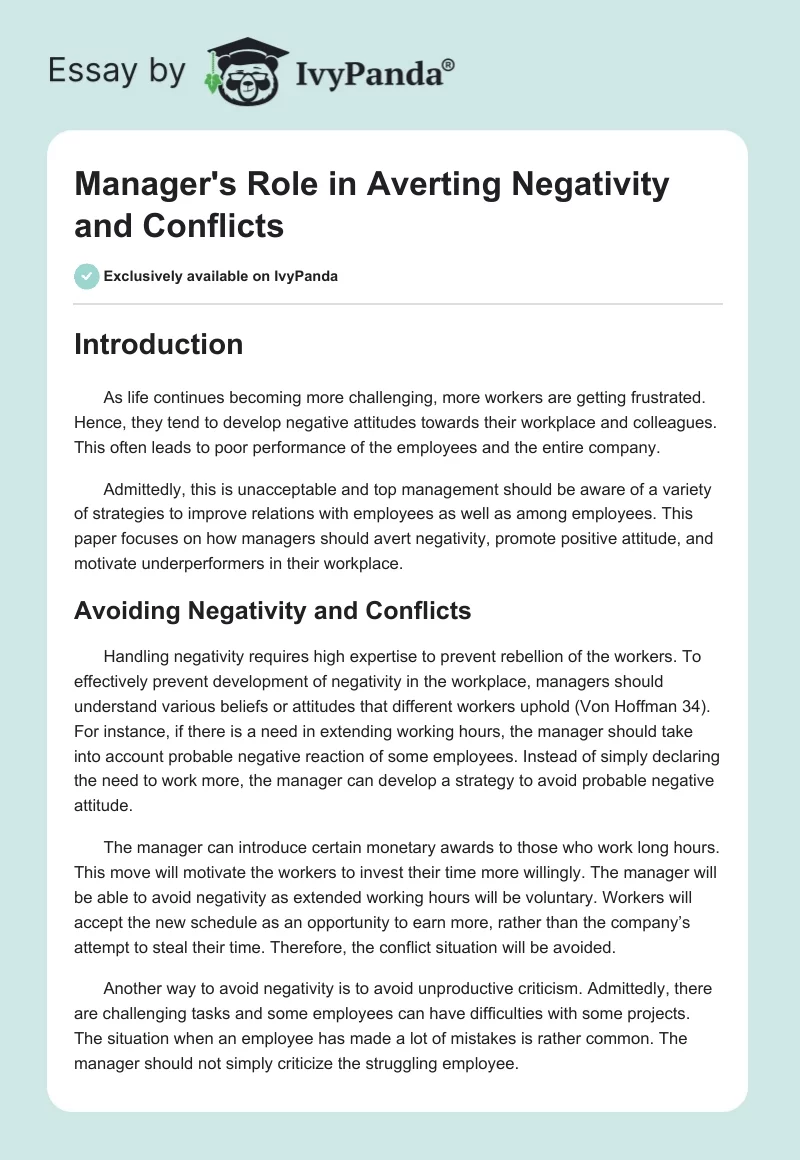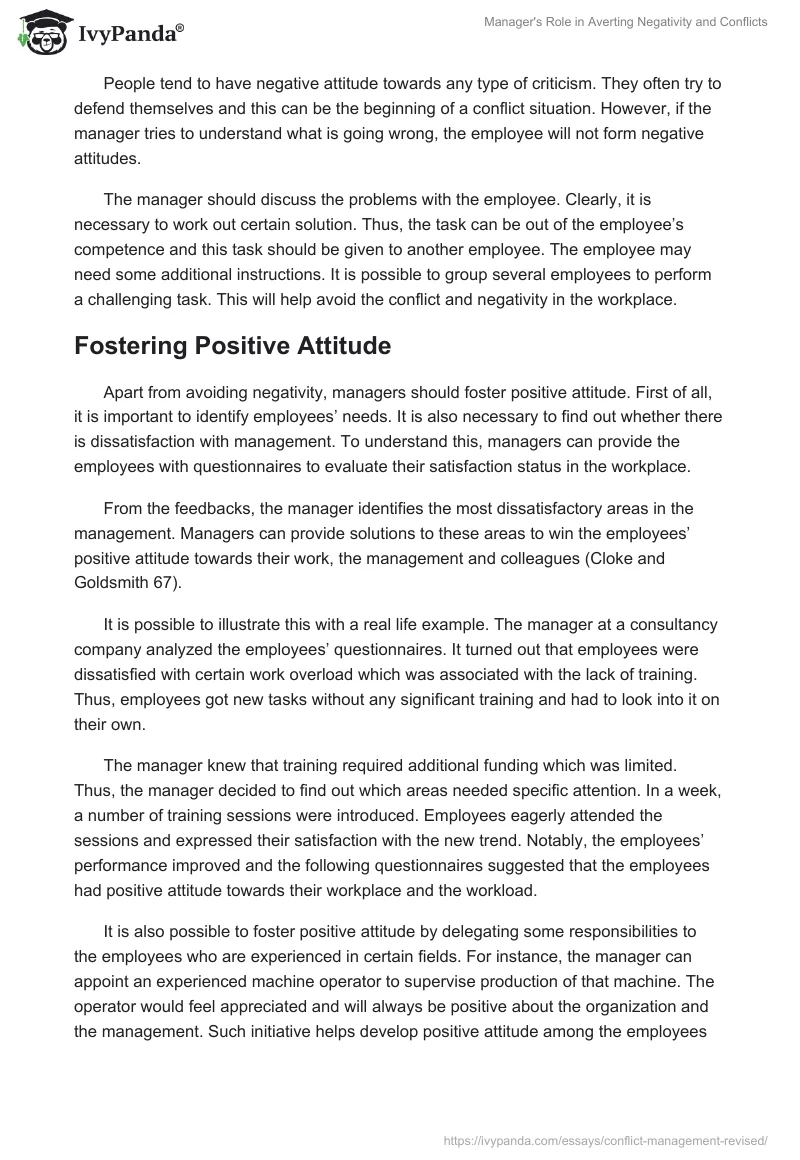Introduction
As life continues becoming more challenging, more workers are getting frustrated. Hence, they tend to develop negative attitudes towards their workplace and colleagues. This often leads to poor performance of the employees and the entire company.
Admittedly, this is unacceptable and top management should be aware of a variety of strategies to improve relations with employees as well as among employees. This paper focuses on how managers should avert negativity, promote positive attitude, and motivate underperformers in their workplace.
Avoiding Negativity and Conflicts
Handling negativity requires high expertise to prevent rebellion of the workers. To effectively prevent development of negativity in the workplace, managers should understand various beliefs or attitudes that different workers uphold (Von Hoffman 34). For instance, if there is a need in extending working hours, the manager should take into account probable negative reaction of some employees. Instead of simply declaring the need to work more, the manager can develop a strategy to avoid probable negative attitude.
The manager can introduce certain monetary awards to those who work long hours. This move will motivate the workers to invest their time more willingly. The manager will be able to avoid negativity as extended working hours will be voluntary. Workers will accept the new schedule as an opportunity to earn more, rather than the company’s attempt to steal their time. Therefore, the conflict situation will be avoided.
Another way to avoid negativity is to avoid unproductive criticism. Admittedly, there are challenging tasks and some employees can have difficulties with some projects. The situation when an employee has made a lot of mistakes is rather common. The manager should not simply criticize the struggling employee.
People tend to have negative attitude towards any type of criticism. They often try to defend themselves and this can be the beginning of a conflict situation. However, if the manager tries to understand what is going wrong, the employee will not form negative attitudes.
The manager should discuss the problems with the employee. Clearly, it is necessary to work out certain solution. Thus, the task can be out of the employee’s competence and this task should be given to another employee. The employee may need some additional instructions. It is possible to group several employees to perform a challenging task. This will help avoid the conflict and negativity in the workplace.
Fostering Positive Attitude
Apart from avoiding negativity, managers should foster positive attitude. First of all, it is important to identify employees’ needs. It is also necessary to find out whether there is dissatisfaction with management. To understand this, managers can provide the employees with questionnaires to evaluate their satisfaction status in the workplace.
From the feedbacks, the manager identifies the most dissatisfactory areas in the management. Managers can provide solutions to these areas to win the employees’ positive attitude towards their work, the management and colleagues (Cloke and Goldsmith 67).
It is possible to illustrate this with a real life example. The manager at a consultancy company analyzed the employees’ questionnaires. It turned out that employees were dissatisfied with certain work overload which was associated with the lack of training. Thus, employees got new tasks without any significant training and had to look into it on their own.
The manager knew that training required additional funding which was limited. Thus, the manager decided to find out which areas needed specific attention. In a week, a number of training sessions were introduced. Employees eagerly attended the sessions and expressed their satisfaction with the new trend. Notably, the employees’ performance improved and the following questionnaires suggested that the employees had positive attitude towards their workplace and the workload.
It is also possible to foster positive attitude by delegating some responsibilities to the employees who are experienced in certain fields. For instance, the manager can appoint an experienced machine operator to supervise production of that machine. The operator would feel appreciated and will always be positive about the organization and the management. Such initiative helps develop positive attitude among the employees (Saunders 72). This strategy can also be illustrated by the example mentioned in the previous section.
The consulting company had limited resources but the employees needed certain training. The manager identified the areas which had to be addressed. He also identified an employee who was an expert in that area. The employee was flattered to become a trainer and was eager to help as she had been constantly distracted by employees who asked for help. The employee who became the trainer developed positive attitude and developed proper relationships with others.
Motivating Underperformers
Finally, it is important for executives and managers to embrace underperformance motivating programs in their organizations (Michelman 47). In the first place, it is crucial to identify underperformers. This can be achieved through accessing the past records as well as the opinions of other people about the performance of an underperforming employee (Michelman 49).
As has been mentioned above criticism will only lead to negative attitude and conflict situations. Many companies introduce a system of various rewards to motivate underperformers. One of the commonest ways to reward an employee is to pay extra. However, promotion can also be the necessary motivation. Thus, mobility within the company can facilitate employees’ motivation.
For instance, the consultancy company mentioned above can be an example of an organization that successfully employs this strategy. At this point, it is important to note that the company resorts to monetary rewards as well. However, horizontal as well as vertical mobility is typical of the company.
Thus, employees complete routine procedures and often have projects which need specific approaches. Noteworthy, employees prefer to have more sophisticated tasks than routine tasks. Those who perform tasks properly get more sophisticated projects which are associated with larger satisfaction with job. Underperformers are given more routine projects.
If the employee is still underperforming, the manager discusses this with the employee (possibility of training is also discussed). There are two possible solutions, i.e. the employee is usually given some sophisticated projects and if he/she performs well, the employee gets rewards. If the employee is not ready to work hard, he/she is fired. Notably, there are almost no underperforming employees in the company.
Conclusion
To sum up, it is possible to note that it is crucial to avoid negativity and conflicts, foster positive attitude and motivate underperformers in the workplace. It is also important to make sure that employees form proper relationships with each other and management. There are various strategies to develop positive environment in the workplace. Therefore, it is essential to try such strategies before making a decision to fire an employee.
Works Cited
Cloke, Ken and Joan Goldsmith. “How to Handle Difficult Behaviors.” Dealing with Difficult People. Boston, MA: Harvard Business Press, 2005. 66-70. Print.
Michelman, Paul. “Will You Help or Heave Your Underperformers.” Dealing with Difficult People. Boston, MA: Harvard Business Press, 2005. 46-49. Print.
Saunders, Rebecca M. “When to Walk Away from a Fight.” Dealing with Difficult People. Boston, MA: Harvard Business Press, 2005. 71-79. Print.
Von Hoffman, Constantine. “Crabs, Cranks, and Curmudgeons.” Dealing with Difficult People. Boston, MA: Harvard Business Press, 2005. 34-41. Print.


